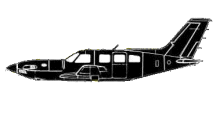
ASN Wikibase Occurrence # 16857
This information is added by users of ASN. Neither ASN nor the Flight Safety Foundation are responsible for the completeness or correctness of this information.
If you feel this information is incomplete or incorrect, you can submit corrected information.
| Date: | Friday 28 March 2008 |
| Time: | 08:15 |
| Type: |  Piper PA-46-350P Malibu Mirage JetPROP DLX |
| Owner/operator: | A.D. Williams Engineering Inc. |
| Registration: | C-FKKH |
| MSN: | 4622092 |
| Year of manufacture: | 1989 |
| Engine model: | PWC PT6A-35 |
| Fatalities: | Fatalities: 5 / Occupants: 5 |
| Aircraft damage: | Destroyed |
| Category: | Accident |
| Location: | 12km NE of Wainwright, AB -
 Canada Canada
|
| Phase: | En route |
| Nature: | Executive |
| Departure airport: | CYXD |
| CYWG | |
| Investigating agency: | TSB |
| Confidence Rating: |
The aircraft took off from Edmonton at about 07:30 local time en route to Winnipeg.
Edmonton ATC saw the plane behaving erratically on radar and contacted the pilot, who said the plane had gyro problems. The plane rapidly descended and crashed at about 08:15. The wreckage was discovered in dense bush around 12 p.m. by a Griffon helicopter operated out of CFB Cold Lake. Investigation revealed, among other things, that the aircraft was overweight by some 400 kilos, and when the gyro instrument failed in flight and the autopilot was disconnected, the pilot lost control and the plane entered a high speed dive and the aircraft disintegrated due to excessive forces placed on the structures.
Findings as to Causes and Contributing Factors
1.The gyro/horizon failed due to excessive wear on bearings and other components, resulting from a lack of maintenance and due to a vacuum system that was possibly not at minimum operating requirements for the instrument.
2.The gyro/horizon was reinstalled into the aircraft to complete the occurrence flight without the benefit of the recommended overhaul.
3.The autopilot became unusable when the attitude information from the gyro/horizon was disrupted.
4.The pilot had not practised partial panel instrument flying for a number of years, was not able to transition to a partial panel situation, and lost control of the aircraft while flying in instrument meteorological conditions.
5.The aircraft was loaded in excess of its certified gross weight and had a centre of gravity (C of G) that exceeded its aft limit. These two factors made the aircraft more difficult to handle due to an increase of the aircraft's pitch control sensitivity and a reduction of longitudinal stability.
6.The structural limitations of the aircraft were exceeded during the uncontrolled descent; this resulted in the in-flight breakup.
7.There were a number of deficiencies with the company's safety management system (SMS), in which the hazards should have been identified and the associated risks mitigated.
8.The company did not conduct an annual risk assessment as required by its SMS; this increased the risk that a hazard could go undetected.
9.The Canadian Business Aviation Association (CBAA) audit did not identify the risks in the company's operations.
Findings as to Risk
1.Lack of adequate instrument redundancy increases the risk of loss of control in single-pilot instrument flight rules (IFR) aircraft operations.
2.The pilot did not reduce his airspeed while attempting to maintain control of the aircraft; a lower speed would have allowed a greater margin to maximum operating speed (Vmo) while manoeuvring.
3.There were no quick-donning oxygen masks on board and the pilot was not wearing an oxygen mask at the time of the occurrence, as required by regulation.
4.If effective oversight of private operator certificate (POC) holders is not exercised by the regulator or its delegated organization, there is an increased risk that safety deficiencies will not be identified and properly addressed.
Other Finding
1.The approved maintenance organization (AMO) that was maintaining the aircraft did not have the approval to maintain PA-46 turbine aircraft.
Accident investigation:
 |
|
Sources:
https://www.ctv.ca/servlet/ArticleNews/story/CTVNews/20080329/alta_planecrash_080331/20080331
CADORS
https://flightaware.com/live/flight/CFKKH
CTV\
https://www.ctv.ca/servlet/ArticleNews/story/CTVNews/20091209/plane_probe_091209/20091209?hub=Canada
http://www.jetprop.com/phpix3/view.php?album=JetPROP&pic=JetPROP_113_C-FKKH.jpg&dispsize=512&start=100&picindex=112 (photo)
http://www.tsb.gc.ca/eng/rapports-reports/aviation/2008/a08w0068/a08w0068.asp
Revision history:
| Date/time | Contributor | Updates |
|---|---|---|
| 28-Mar-2008 11:44 | harro | Added |
| 28-Mar-2008 23:49 | harro | Updated |
| 31-Mar-2008 21:02 | dhoisak | Updated |
| 02-Apr-2008 04:36 | harro | Updated |
| 09-Dec-2009 21:20 | slowkid | Updated |
| 09-Dec-2009 23:47 | RobertMB | Updated |
| 25-Jul-2010 23:45 | eod | Updated [Source, Narrative] |
| 03-Oct-2016 12:25 | Aerossurance | Updated [Aircraft type, Source, Narrative] |
Corrections or additions? ... Edit this accident description
The Aviation Safety Network is an exclusive service provided by:


 ©2024 Flight Safety Foundation
©2024 Flight Safety Foundation